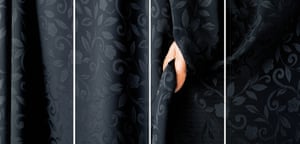Saeed Kamali Dehghan - 'Is it art or pain?' Iran's Parastou Forouhar on family, death and the failed revolution
Every autumn, the
Iranian artist Parastou Forouhar returns to Tehran from Germany to hold a
memorial service for her murdered parents.
Dariush Forouhar, a
secular politician, and his wife, Parvaneh, were two of Iran’s most
high-profile political activists when they were stabbed to death in their home
on 22 November 1998. The killers placed her father’s body in a chair facing
towards the Qibla, the direction of Mecca. “I called a close
friend of my parents in Paris and he was crying,” Forouhar says. “I thought, it
mustn’t be just an arrest. We were used to [arrests]. I said, is Dad killed? He
said, it’s not just your dad.”

Work by Parastou Forouhar. Photograph: Courtesy of the artist
Every year since,
Parastou has gathered with close relatives to light a candle and pay tribute to
her parents’ secular democratic values. The public are routinely blocked from
attending by security officials. “They won’t let people
in for the ceremony [but] it gets media coverage and it becomes an act of
protest,” says Forouhar, whose work was recently exhibited at Pi Artworks in
London.
Forouhar says
regularly revisiting the suffering she has endured for nearly 20 years has
helped to heal the wounds of her past. “When I work, I also
have pain, you want to move on but also reproduce the pain at the same time,”
she says. “Sometimes I can’t distinguish; is it art or pain? It’s really like
finding healing in repetition. For me, the way to deal with pain is to
reproduce it in art.”
The murder of
Forouhar’s parents shone a spotlight on the killings and disappearances of other
Iranian dissident intellectuals in the 1990s and created an atmosphere of fear
that helped put the brakes on the reformist agenda of President Mohammad
Khatami. In a rare admission in
1999, Iran’s ministry of intelligence took responsibility for the killings,
saying it had “committed these criminal activities … under the influence of
undercover rogue agents”. Saeed Hajjarian, a reformist politician and
journalist involved in revealing the “chain murders”, survived an attempted
murder the following year but was left severely disabled.
Forouhar studied art
at Tehran University after the 1979 Islamic revolution and says it was the
failure of the revolution that made her the artist she is today. “We thought, we’ll
build a better life, we thought it was possible, but then we realised those who
hijacked the revolution are suppressing the segment of the society that did not
approve of revolutionary policies,” she said. “The streets turned unsafe and
the arrests and the executions followed.”
She left for Germany
in 1991, graduating with a master’s from Offenbach am Main and holding her
first exhibition at her university in 1994. Forouhar established a portfolio of
works that she defines as being between “abstraction and the formation of
metaphors”, drawing on what she learned in Tehran, when students expressed
dissent through highly coded and alternative methods… read more:
see also
